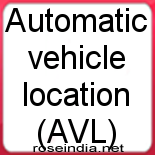Automatic vehicle location (AVL)
Introduction:
AVL enables one to locate any vehicle through internet in seconds and minutes and protect one’s remotely placed asset or in other words can say that it enables operators to monitor their vehicles.
Automatic vehicle location is also called Telelocation and is an important tool which identifies a vehicle with regard to its geographic position. This sends the information related to this to the station. Most commonly used technology in this process is GPS. All the information is transmitted from the vehicle with the help of satellites, radio stations or any other cellular network to the end user.
AVL is not a single device but a combination of various technologies and techniques. To serve this purpose it makes use of different technologies such as dead reckoning, inertial navigation, or RFID (Radio Frequency Identification) readers, street mapping, cellular communications. Other technologies for example GSM and EVDO (Evolution Data Optimised) are more popular with AVL as these reduce the cost and also because low data rate is required for AVL.
Any vehicles fleet whether service vehicles, emergency vehicles or public vehicles can be managed efficiently. This technology also helps to track mobile assets. This will increase the security of such machinery, which can not be taken from one place to other easily.
Different systems:
There are different systems used for this, for example direction finding, signposts system, global positioning system. The direction finding simply calculates the bearing from two fixed sites to the mobile. This creates a triangle with endpoints at the two fixed points and the mobile. The signpost system is used on fixed routes and rail lines which need to be tracked regularly. GPS technology does not work where terrestrial hurdles come across and signals are not relayed.
GPS is most popular not only due to lower cost but also easy to use as the whole system is not required to be placed on the vehicle. The only instruments used are a receiver in the vehicle and a radio to send the stored data. Its resistance to sounds produced by the electronic machines is another reason which makes it more reliable.
Components of AVL system:
System normally contains various instruments as follows:
- Mobile radio receiver,
- GPS receiver,
- GPS modem,
- Antenna
- GPS base station
- Wireless communication (two way radio or cellular phone)
- GPS tracking software
- Data stream processing servers
GPS software is a combination of road mapping and GPS tracking functions
Benefits:
- AVL system first of all increases the safety and security of drivers and passengers as well which is most important concern.
- Another important benefit is the operational efficiency of the fleet.
- This also provides improved and safe departures and arrivals of the fleet.
- System improves customer service consequently increases customer satisfaction.
- This also gives a chance of exact service performance of the agencies and better planning for future.
- System helps to keep a watch on the time schedule of the vehicles and punctuate the whole system
- One can have information about the whereabouts of the passengers boarded on the vehicle.
- Ultimately a better management and utilization of the fleet at a lower cost and reduced labour, fuel.
- With the knowledge of whereabouts of the vehicles, it could be redirected to provide timely delivery. This fact can prove very useful for companies as they can develop a delivery road-map by analysing database of vehicle information
- AVL increases accountability of the on field man, thus increases the performance of the company.



